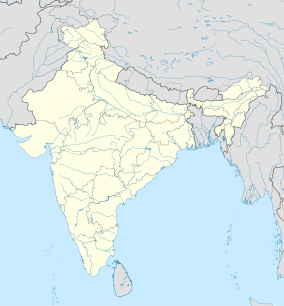Mrugavani National Park

| Mrugavani National Park | |
|---|---|
 Pied Cuckoo at Mrugavani National Park | |
| Location | Chilkur near Hyderabad, Telangana |
| Nearest city | Hyderabad |
| Coordinates | 17°21′19″N 78°20′17″E / 17.355228°N 78.338159°E |
| Area | 1,211 acres (4.90 km2) |
Mrugavani National Park is a national park located in Hyderabad, Telangana State, India. It is situated at Chilkur in Moinabad mandal, 20 km from MGBS and covers an area of 3.6 square kilometres (1.4 sq mi) or 1211 acres. It is home to a 600 different types of plant life. The Park is home to around 350 spotted deer. The animals include: indian hare, forest cat, civet, Indian rat snake, Russell's viper, chital and the flower pecker.[1][2]
History
[edit]It was declared as a National Park in 1994.
Flora and Fauna
[edit]Teak, Bamboo, Sandal, Picus, Palas, Rela. The plant species include bryophytes, Pteridophytes, Herbs, Shrubs, Climbers and Trees. The vegetative cover presents a mosaic of woodland and grasslands. The plants of the park is of tropical waterless deciduous forest of degraded nature. Cheetal, Sambar, Wild boar, Jungle Cat, Civet Cat, Mongoose Monitor Lizard, Python, Russell Viper, King Cobra. The animals which are found here are Cheetal, Sambar, Wild boar, Jungle Cat, Civet Cat, Mongoose Monitor Lizard, Python, Russell Viper etc. Apart from the varied flora and fauna the Mrugavani National Park boasts of more than 100 species of birds including warblers, peacocks, lapwings, and flower peckers.
The climate here is pleasant most of the time. There is a point in the park which is at a height for high point views and there is also a watch tower so as to watch animals closely.
There is also a library and Education center in regards to the Environment a museum and auditorium which exhibits wildlife. Visitors may also go for safari rides for those willing to get closer to the park's denizens, besides nature walks with guides.
The topography of Park supports woodlands, grasslands and rocky areas. Most of the vegetation can be classified as southern tropical dry deciduous forests. The Park does the significant job of conserving the near disappearing native flora of Hyderabad region.
Seasons
[edit]Winter – November to February
Summer – March to May
Monsoon – June to October
Average rainfall: 300 to 750 mm
Temperature: Maximum 40 °C, Minimum 10 °C
Coordinates: 17° 21’ 27.79″ N, 78° 20’ 26.91″ E
Dominant flora and fauna
[edit]Teak, Bamboo, Sandal, Picus, Palas, Rela etc.
They are dry deciduous forest in the Southern tropical. The undulating topography shows the rocky side of the formation of the Deccan trap. Mammals – Panther, Cheetal, Sambar, Wild boar, Jungle Cat, Civet Cat, Mongoose, Jackals, Porcupines, fox, Black naped Hare etc.
Reptiles – Snakes, Rat Snakes, Monitor Lizard, Russell Viper, Cobra etc.
Birds – Quails, Peacocks, Warblers, Partridges, Flower Peckers, Ducks, Curlews, Lapwings, Babbler, Koel etc.
Location
[edit]The Park is in near Chilkur Balaji Temple, about 20 km by road from MGBS
See also
[edit]References
[edit]- ^ "Wild Life in Telangana :: Telangana Tourism". telanganatourism.gov.in. Retrieved 18 April 2018.
- ^ Borah, Prabalika M. (11 January 2018). "Dear, how about some deer spotting?". Retrieved 18 April 2018 – via www.thehindu.com.
External links
[edit]- Forest Department description (archived 8 January 2012)

